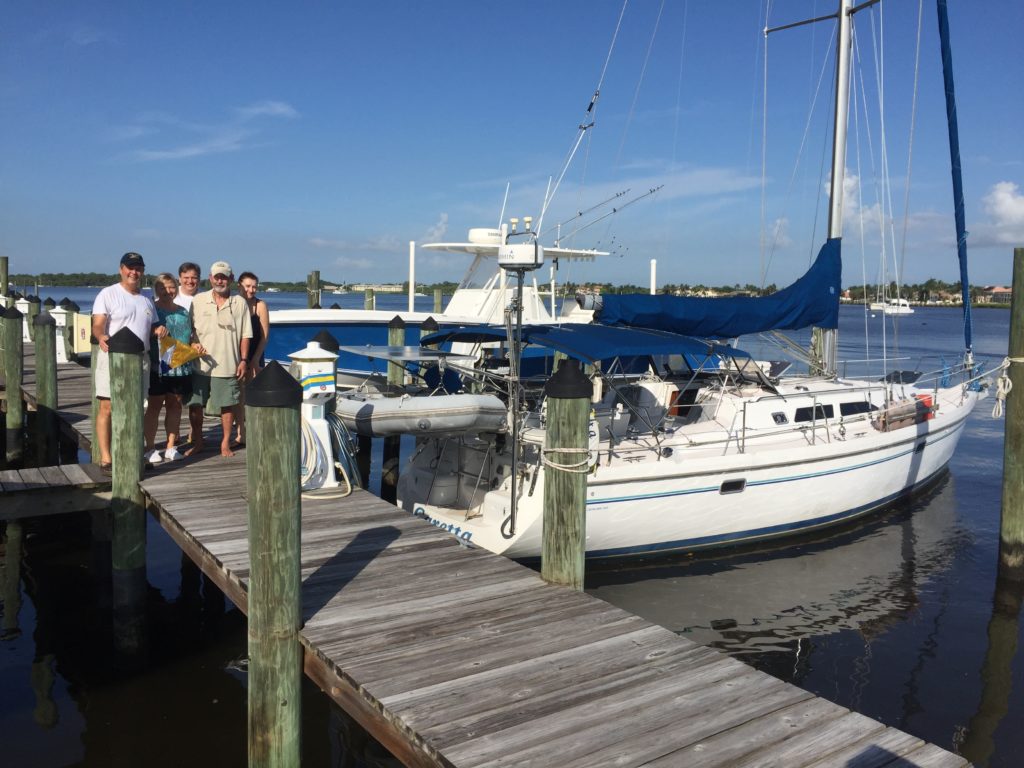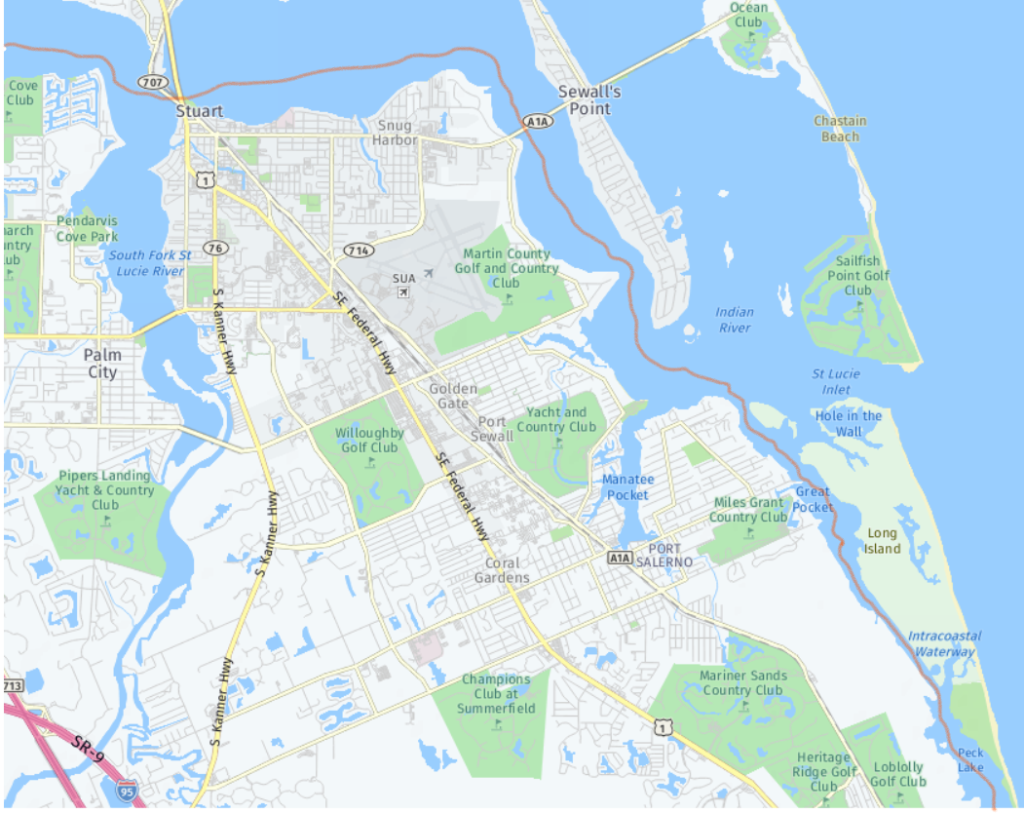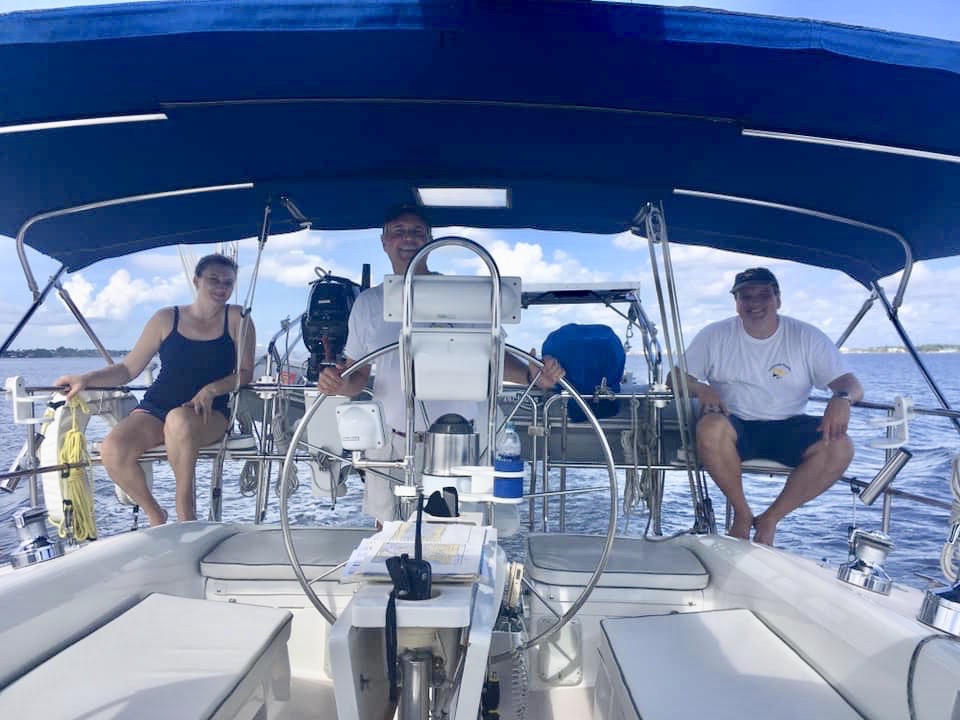If one advances confidently in the direction of his dreams,
and endeavors to live the life which he has imagined,
he will meet with a success unexpected in common hours.
–Henry David Thoreau
I am sitting on my boat in front of the laptop. It’s a bright summer day, and the sun is warm on my back where it shines down the companionway. Phil is at his office, but I was given a furlough from work and stay pretty close to our pier. Yes, we live on our boat now. We spent almost five years in a small apartment by the water, with our old 27-foot Catalina sailboat tied to a nearby dock. We built up our savings, made great friends, and lived our lives.
We shared a dream of moving aboard a sailboat and cruising through the Keys, the Bahamas and beyond. Of course, we needed a bigger boat. So, in 2019, we started shopping for a boat. We knew we wanted another Catalina, but would consider a comparable Jeanneau or Beneteau. Our search took us all over South Florida, from Marco Island to Port Charlotte to Port St. Lucie.

In February we found Mañana in Marco Island on the west coast of Florida. She was a gorgeous, well-loved Catalina 380 that could have been ours. But in truth, we weren’t quite ready to pull the trigger and because of our delay, we lost it. I was heartbroken. It reminded me of losing the first car I tried to buy. I lost that, too, because I was too slow to offer a cash deposit. It was a 1971 Toyota Celica, teal with a white racing stripe. I’m still bitter.
In June we found Caretta, a Catalina 380 in sail-away condition that was almost, but not quite, in our price range. We would have missed it if we hadn’t loosened our pricing limits in the search engine on BoatTrader.com. At the same time, the seller dropped his price below $100,000. We drove to Stuart, met the owner and fell in love with the boat. Walking away from the dock that first afternoon, after a comprehensive tour of Caretta and all of her upgrades, I said to Phil, “I think that’s our boat.”

What followed was a series of emailed negotiations that I found uncomfortable and embarrassing. Phil managed to get the price down to $89,500, which the seller called, “Close enough for government work.” To pick up the boat, we decided to drive to Stuart in my car, leaving Phil’s car at our apartment. We arranged for our good friends, Ben and Mari to accompany us on the trip south, so we would have extra hands on an unfamiliar vessel. It turned out to be a very good decision when trying to dock Caretta for the first time.
On Friday night, there was last-minute drama. We had booked a hotel room for one night and had dinner at the tiki bar. Other patrons at the tiki bar were in on the drama, as we waited for word. The owner did not have the money in his account and would not let us take the boat until he did. We couldn’t ask our friends to drive up from Fort Lauderdale if we weren’t sure the transaction would take place. On our end, we had the financing, but had to wait for the insurance binder. The finance company wouldn’t transfer the money until insurance was verified, so it was nearly 6 when we got the call from the owner. “Caretta is yours,” is all he said.

There was applause all around the tiki bar when we announced our news. We called our friends and they offered to drive the 90 minutes right then. Two hours later, they arrived at the same hotel and found us still at the tiki bar, celebrating. Tomorrow was moving day.
Steve Dublin had owned Caretta since at least 2005, nearly 15 years. There’s a plaque in the salon that says the boat took second place in the 2005 Fort Lauderdale to Key West race, and Dublin had the same picture in his home office. So I know it was a sad day for him, even though we had given him about $10,000 more than the “blue book” value for the boat. When I remarked at how clean it was, he said, “It was my baby.” I could see the pride in his face and felt his loss.
He met us on the dock at 9 the next morning. Steve Dublin had belonged to our sailing club once upon a time, and Phil was the current commodore. We took pictures with the club burgee, and Steve and his wife handed off the lines. They stood for a long while on the deserted pier watching us motor toward the bridge.

The trip from Stuart to our apartment near Pompano Beach took about 90 minutes by car, but it’s a two-day journey by sailboat. To make the trip even slower, there are around 23 bridges over the Intracoastal Waterway, and each one opens twice an hour. As we approached each bridge, we had to call the bridge tender on the VHF radio, then wait for the scheduled opening.
The first bridge was tricky because there was a train bridge close to the drawbridge, and a strong current. Since our mast is 62-feet high, and the highway bridges are 65 feet, it looks like a close call as we slide underneath. I’ve seen Phil doing the sign of the cross for extra assurance. We made it through just fine, and I took a turn steering on the other side.

Just past Manatee Pocket, which is a popular anchorage opposite the St. Lucie Channel, we turned right to join the ICW. It would have been much faster to keep heading east and sail the boat on the open ocean down to Hillsboro Inlet. But we had never sailed such a large vessel, and even with extra hands on board, it was too risky to take that route.
Phil was driving as we turned into the waterway, and the boat grazed the bottom in a spot where the charts indicated we had 14 feet below us. It was just a quick brush through light sand, a momentary slowdown, and on we went. It was a reminder that our draft had increased from 4’6” on the old boat to 5’4” on the new one, and that shoaling was always a possibility near ocean inlets.

With six bridges behind us, we arrived at our marina for the first night. It was close to a couple of good anchorages near Peanut Island in West Palm Beach, but it was July in Florida, and we wanted the air conditioning that a marina could provide. Trying to pull into a narrow slip in reverse on an unfamiliar vessel was a challenge. With the help of Ben fending off the yacht next door, we managed to inch our way in and dock. Unfortunately, the air conditioning would not operate, and Phil had to call Steve, the former owner. With instructions on bleeding the water lines, Phil managed to get it going (while sweating buckets!) and we all headed to the outdoor bar for rum drinks and dinner.

The next day would bring us through 17 bridges, past wildlife refuges, two ocean inlets, and traffic jams of power boats. It was hot and sticky, but we had a steady breeze while we were moving. Waiting for bridges could be miserable, but we were lucky in most cases and motored right through. Occasionally, a bridge tender would hold the bridge open a minute or two as we caught up to the boat traffic going through. By late afternoon, we started to see familiar sights and approached our home port, Port Royale, just south of Pompano Beach. We arrived at cocktail time, but we still had a road trip in front of us, so no drinks for the moment.
Pulling into our slip, we could see the huge difference in size between our old Catmandu and Caretta. Catmandu, a Catalina 27, was parked in her slip next door, so Caretta – at 38 feet – looked like the big brother. Caretta’s mast towered about 20 feet above the mast of Catmandu. Despite the size difference, we had no problem docking, tying the lines and securing our new boat next to our old one.

What I remember about our drive back to our cars in Stuart was both laughter and sadness. Laughter – because Phil’s Chrysler Sebring made hilarious croaking noises with every bump in the road; and sadness because I couldn’t forget the lonely figure of Steve Dublin standing at his empty dock watching Caretta cross under the bridge without him.